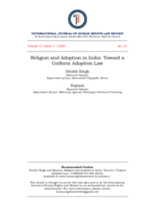India’s adoption laws reflect layers of history and belief. In 1890, the Guardians and Wards Act created a guardianship route for non-Hindu families, leaving the child tied to birthline inheritance. Sixty-six years later, the Hindu Adoptions and Maintenance Act established a clear path for Hindus, Sikhs, Jains, and Buddhists to adopt—and to grant full inheritance rights. A more open option emerged with the Juvenile Justice (Care and Protection of Children) Act in 2015, inviting any citizen to take in an orphan or abandoned child. Yet the old Hindu statute remains alive, producing two parallel systems. That gap affects who can adopt, how quickly a child finds a home, and which rights a new family enjoys. This study traces each law’s origins, unpacks the holes they leave, and looks at how outcomes vary by community. It brings together a doctrinal analysis to build a single, cohesive adoption law- one that honors India’s constitution and its international obligations.

